Over the next several weeks, we’re spotlighting the top 20 3D Jam experiences chosen by the jury and community votes. These spotlights will focus on game design, interaction design, and the big ideas driving our community forward.
Martin Schubert’s Weightless won second place for its breathtaking atmosphere and fluid interaction mechanics. It’s available free for the Oculus Rift on the Leap Motion App Store.
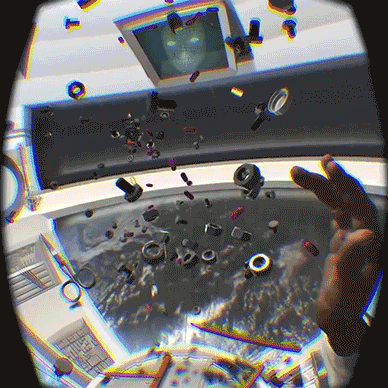
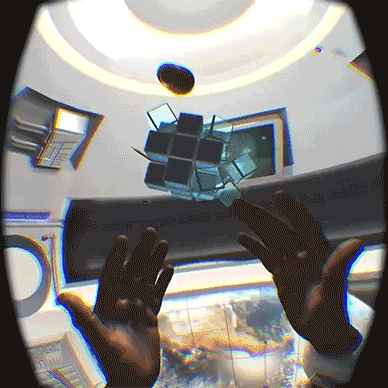
The space station in Weightless has an area that feels like a sci-fi museum. What inspired that?
The cabin is essentially a zero-G playground, so I wanted to add as much detail as I could (in 6 weeks!) to make the space feel interesting. Since you start in the sleeping quarters, I wanted to set the tone of the experience there.
As I was building, I kept thinking about how real astronauts must’ve felt when they finally got up into orbit and floated weightlessly for the first time. The awe and the sense of being on the frontier of human exploration. So I chose quotes from real scientists, astronauts, and an architect and put them next to historic photos of space exploration – as a kind of inspiration board of our progress so far.
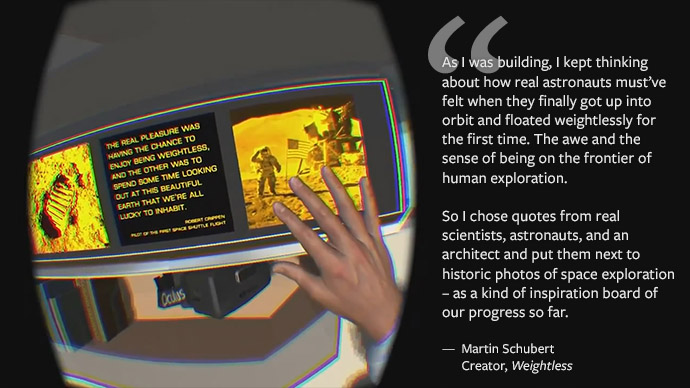
One of the museum set pieces is a quote from Alan Watts. What’s the significance there?
Alan Watts was an influential philosopher in the ‘60s in San Francisco who popularized Eastern philosophy to a Western audience. I’ve listened to a lot of his lectures, and the way he communicates very old philosophical concepts through engaging, elegant trains of thought always gets me. His words on the concept of reality in particular are increasingly relevant with the rise of VR. So much of our lives happen in the digital world already, defining the material world as the only true ‘reality’ is only going to become more difficult as technology progresses.
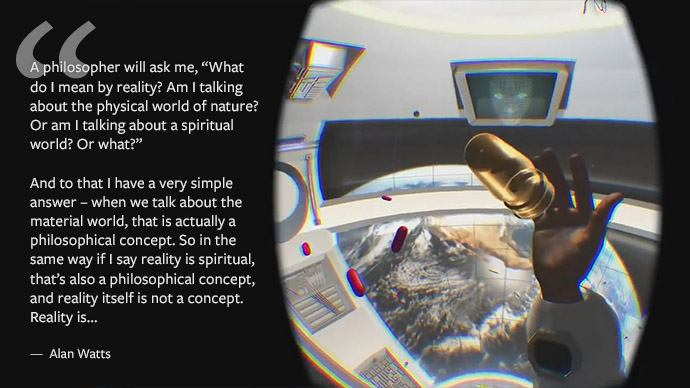
With that in mind, what is the difference between the human world and “reality”?
Tough question. I guess it all depends on how you define those terms. Without getting too metaphysical, I think reality (or the universe or everything, however you want to define it) exists through our experience of it. For millions of years, humans experienced only the physical world and evolved to survive in it. As our communication developed we told tales of the spiritual world and through various explanations tied proof of its existence to the physical world.
In the last century, we’ve created the digital world, which has already changed society beyond measure. From displaying text to 2D images to fully realized digital 3D worlds. Up until recently I believe we’ve been living in the age of 2-dimensional representations of the 3-dimensional digital world (i.e. viewing a 3D world through a 2D monitor). With VR and AR, we’re about to step into the age of 3-dimensional representations of the 3-dimensional digital world. That’s going to be a big, big step.
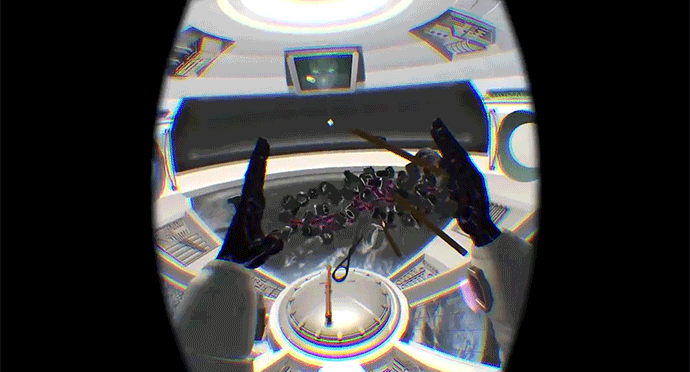
Weightless is a meditative experience with a goal: sorting different objects. What’s the appeal behind not just passive exploration, but active understanding and categorization?
The main mechanic is gently nudging objects with your fingers, but the narrative motivation behind that mechanic is that you’re trying to sort through and categorize space debris. There are games that use passive exploration brilliantly to tell a great story (The Stanley Parable comes to mind), but the Leap as an input device begs to be used and used often. So passive exploration didn’t seem like a good fit.
Through play testing, I found that the physicality of touching floating objects was really engaging, so I decided to explore the potential of physics interactions. That led to objects with hinges, objects that contained smaller objects, and non-human objects that have their own gravity or could change scale. I still have a lot more I want to explore!
What do virtual reality and outer space have in common?
I think everyone wants to experience floating weightlessly in orbit or outer space and for the majority of people virtual reality is the closest they’ll ever get to the real thing. That’s one of the greatest things about virtual reality I think, the ability to do things and go places that for most people would never be possible in the real world. And then on top of that, the potential to do things and go places that don’t exist anywhere in the real world and are pulled straight out of the creator’s imagination.
The piano score in the game is really distinctive. How did you find Chris Zabriskie, and what role does audio and music have in VR?
I found Chris’ music years ago while pulling all-nighters in architecture school. I’ve been wanting to use his music in a project for a long time, and I think I finally have one that does it justice in Weightless. I think audio is the next big necessity in VR, after vision and input.
I ran out of time during the jam but I plan to add 3D binaural audio to Weightless. RealSpace Audio from Visisonics is amazing and I’m hoping to incorporate their tech soon. There are collision sound effects in there right now, but adding positional audio will really add a lot to the experience.
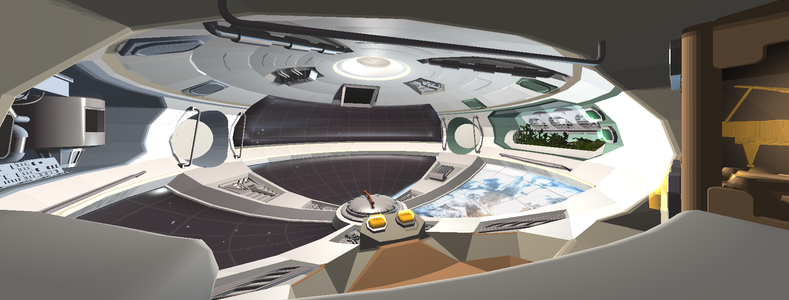
How does your background in architecture inform the structure and artistry of the experiences you create?
Architecture school teaches you about buildings, of course, but more than that it teaches you a way of seeing the world. Studying how humans experience designed spaces means you have to observe and analyze, take things apart, and put them back together. That’s what I loved about it. Training yourself to break things down to understand them transfers to all aspects of life.
In VR I think the potential for applying architectural ideas is staggering. Gone are the limitations of the real world, of budgets and clients. Even the laws of physics don’t apply. I think my background in architecture definitely influences my designs and I’m excited to see how my education can manifest itself in a new medium.
Do you have any UX design tips for other game developers starting with VR?
I think environmental interactions in VR help immerse the user more than traditional UIs and HUDs (unless there’s a contextual reason, like if you’re wearing a futuristic helmet). Also, since we don’t have haptics yet, giving the user visual and audio feedback when they interact with something really helps.
All the interactions in Weightless are done through holographic buttons that occupy physical volumes and change color when you touch them. I was going to use Leap Motion’s VR Widget Buttons because they feel really great and tactile since they use physics to react to your touch. However I wanted to draw attention to certain buttons and have them disappear once they were no longer usable, so that’s how I ended up where I did.
Overall, I’d say just explore and test things with the HMD on. It’s all uncharted territory, which is pretty exciting.
Want to watch Weightless as it continues its journey to the stars? Follow Martin on Twitter @mrschubert.





[…] also plays a crucial role in setting the mood for an experience. Weightless and Hollow, for example, both include tracks that influence how we experience them. The soft piano […]
April 17, 2015 at 9:18 am[…] Intro and Weightless. Two-handed flight has been a cultural touchstone since the days of George Reeves’ Superman. This […]
February 24, 2016 at 6:49 am[…] making of Weightless is also a very informational […]
August 1, 2017 at 3:59 am[…] Weightless Creator Martin Schubert on Designing a Zero-Gravity Sci-Fi Playground […]
January 10, 2018 at 11:41 am